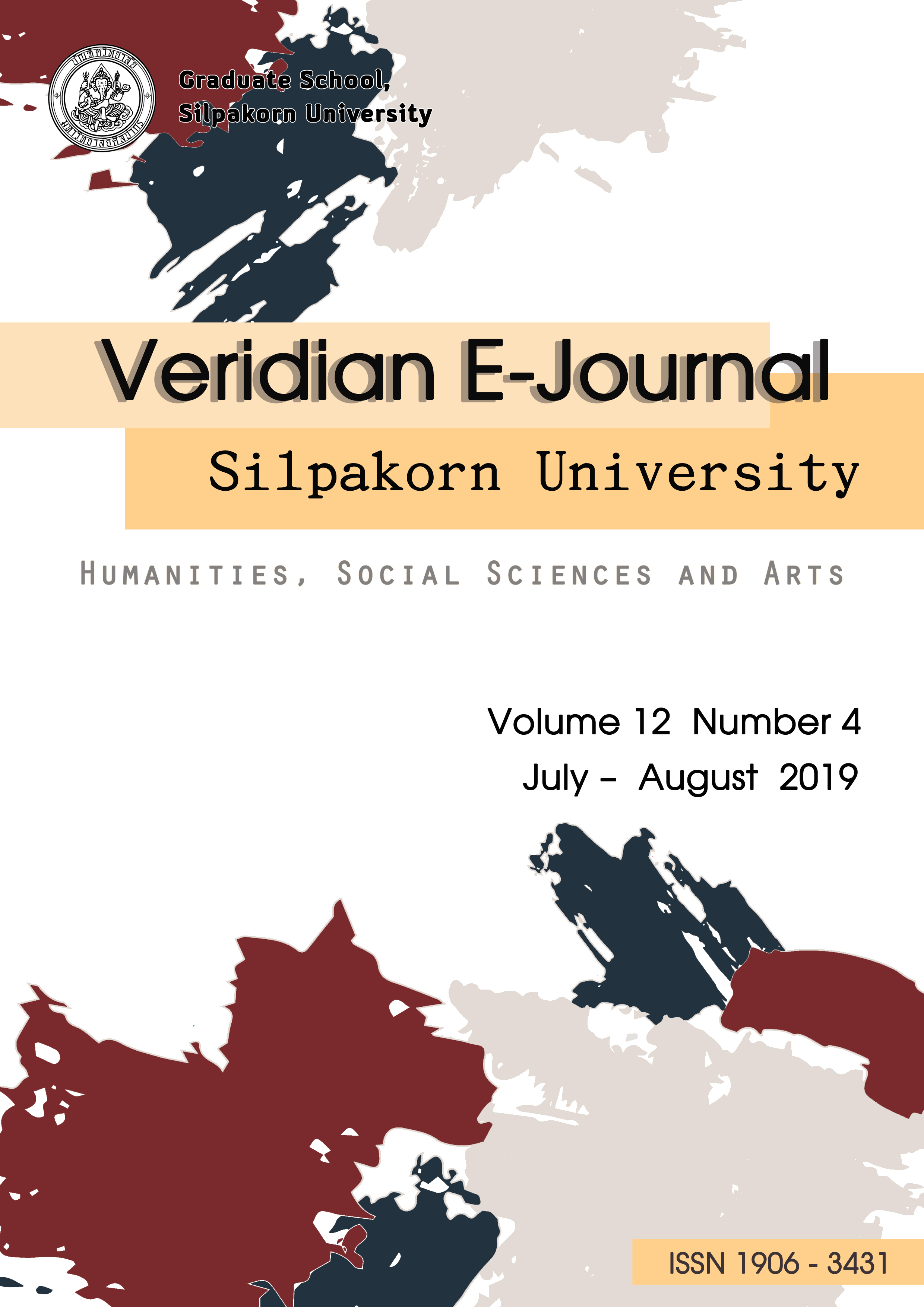แนวทางการพัฒนาการสื่อความหมายในอุทยานประวัติศาสตร์พนมรุ้ง จังหวัดบุรีรัมย์ (A Guideline of Tourism Interpretation Development in Phnom Rung Historical Park, Buriram Province.)
Main Article Content
Abstract
This research titled “A Guideline of Tourism Interpretation Development in Phnom Rung Historical Park, Buriram Province” aims at 1) studying the travel behavior and the tourists' needs for the interpretation in Phnom Rung Historical Park, 2) evaluating the potentials of interpretation management in Phnom Rung Historical Park, and 3) evaluating the perception of history about Phnom Rung Historical Park. Mixed research methodology was used for this study, between qualitative and quantitative research. For the population of the qualitative research, data was collected from 18 relevant interpretation management stakeholders and Thai historical tourists by using a semi-structure interview and content analysis for data analysis. Meanwhile, for the population of the quantitative research, data was collected from 400 Thai tourists who have visited Phnom Rung Historical Park in the year 2018 by using questionnaires for data collection and descriptive statistics, which include frequency, percentage, mean, and S.D.
Regarding the data analysis, the results of travel behavior revealed that most Thai tourists who have visited Phnom Rung Historical Park purposed to traveling or relaxation, visiting a beautiful place, photograph, and checking in to social media then going back home without learning about history. Moreover, they visited for a first times in weekend and received travel information before traveling from relatives, friends, or family. Meanwhile, most of them spent an hour inside the place as well as the key informants that giving more details about some tourists who use the tour guide, spent more than an hour and also particularly revisited with word of mouth. In terms of the needs for the interpretation in Phnom Rung Historical Park represented Thai tourists did not use the tour guides whereas used brochures for learning history similar to the interview results that brochures were the most used communication tools and the majority of tourists did not go inside or some tourists visited only first building because of the time limit or the distance between the third entrance and the tourist information center. The most communication tool that tourists’ desire was printing media including brochures, postcards, handbooks and guidebooks which language to easily understanding, modern communication tools, and innovative communication using while the interview results showed audio guide with headphone service was important. In addition, the potential of interpretation management in Phnom Rung Historical Park in aspects of source or sender, message, channel of interpretation, and receiver were at a high level. This could be considered different from the interview results which raised other issues, including, source or sender, the lack of officers or tour guides; the difficulty to understand academic language; and some outside tour guides lacking information about Phnom Rung Historical Park and making the information short and boring. In terms of the message, the information about art and history was difficult to understand for all groups of tourists. On the other hand, tourist information center, brochures, interpretive signs, and QR Code in terms of communication channel were inappropriate to the area and to the tourists’ needs. Finally, from the interview results, there was a lack of responsibility of some tourists in historical tourist attractions regarding receiver aspect. Furthermore, the perception evaluation of history about Phnom Rung Historical Park were at a lowest level.
According to the results, this research could be analyzed and transformed to be guidelines of tourism interpretation development in Phnom Rung Historical Park, Buriram Province consist of 1) content management for the interpretation in Phnom Rung Historical Park. 2) development of tour guides and communication tools in Phnom Rung Historical Park. 3) broadcasting about tour guides and communication tools in Phnom Rung Historical Park. and 4) historical perceptive creation of Phnom Rung Historical Park which were appropriate to the context of area and to the tourists’ needs.
Article Details
References
2. ชลลดา สิทธิฑูรย์. (2543). แนวทางการพัฒนาการสื่อความหมายธรรมชาติในเขตอุทยานแห่งชาติแก่งกระจาน.
วิทยานิพนธ์ปริญญาศึกษาศาสตรมหาบัณฑิต สาขาวิชาสิ่งแวดล้อมศึกษา มหาวิทยาลัยมหิดล.
3. ณรงค์ โพธิ์พฤกษานันท์. (2556). ระเบียบวิธีวิจัย. (พิมพ์ครั้งที่ 8). กรุงเทพฯ: เอ็กซเปอร์เน็ท.
4. ทัศไนยวรรณ ดวงมาลา และคณะ. (2550). กลยุทธ์ในการส่งเสริมการตลาดการท่องเที่ยวของแหล่งท่องเที่ยวในกลุ่มจังหวัดอีสานใต้. รายงานวิจัยสนับสนุนโดยกองทุนสนับสนุนการวิจัย (สกว.).
5. วิมลสิทธิ์ หรยางกูล. (2549). พฤติกรรมกับสภาพแวดล้อม: มูลฐานทางพฤติกรรมเพื่อการออกแบบและวางแผน. (พิมพ์ครั้งที่ 6). กรุงเทพฯ: สำนักพิมพ์แห่งจุฬาลงกรณ์มหาวิทยาลัย.
6. ศิริชัย กาญจนวาสี และคณะ. (2543). การใช้โปรแกรมคอมพิวเตอร์ SPSS สำหรับงานวิจัย: การวิเคราะห์ข้อมูลและแปลความหมาย. (พิมพ์ครั้งที่ 3). กรุงเทพฯ: โรงพิมพ์แห่งจุฬาลงกรณ์มหาวิทยาลัย.
7. สมภพ ชาตวนิช. (2552). การศึกษาเปรียบเทียบศักยภาพแหล่งท่องเที่ยวด้านศิลปวัฒนธรรมของปราสาทหิน พิมาย และปราสาทเขาพนมรุ้ง. วิทยานิพนธ์ปริญญาวิทยาศาสตรมหาบัณฑิต สาขาวิชาการวางแผนและการจัดการการท่องเที่ยวเพื่อการอนุรักษ์สิ่งแวดล้อม มหาวิทยาลัยศรีนครินทรวิโรฒ.
8. สายันต์ ไพรชาญจิตร์. (2548). การจัดการโบราณสถาน โบราณวัตถุ ศิลปวัตถุ และพิพิธภัณฑ์สถานโดยองค์กรปกครองส่วนท้องถิ่น. กรุงเทพฯ: สถาบันพระปกเกล้า.
9. สุจิตรา ไชยจันทร์. (2553). พฤติกรรมการท่องเที่ยว การแสวงหาข่าวสารการท่องเที่ยว และทัศนคติที่มีต่อคุณลักษณะข่าวสารการท่องเที่ยวบนสื่อออนไลน์ของผู้ใช้อินเตอร์เน็ตในประเทศไทย. รายงานโครงการเฉพาะบุคคลวารสารศาสตรมหาบัณฑิต สาขาวิชาการบริหารสื่อสารมวลชน มหาวิทยาลัยธรรมศาสตร์.
10. สุริยวุฒิ สุขสวัสดิ์, ม. ร. ว. (2549). ปราสาทเขาพนมรุ้ง: ศาสนบรรพตที่งดงามที่สุดในประเทศไทย. (พิมพ์ครั้งที่ 5). กรุงเทพฯ: เรือนบุญ.
11. สุวภัทร ศรีจองแสง. (2558). ศักยภาพการสื่อความหมายของแหล่งท่องเที่ยวทางวัฒนธรรมในเส้นทางท่องเที่ยวตามแนวคิดกลุ่มคลัสเตอร์ด้านการพัฒนาการท่องเที่ยวของกลุ่มท่องเที่ยวอารยธรรมอีสานใต้. รายงานวิจัยตามโครงการสนับสนุนการวิจัยจากสำนักงานคณะกรรมการวิจัยแหล่งชาติ (วช.).
12. De Rojas, C., & Camarero, C. (2008). Visitors’ experience, mood and satisfaction in a heritage context: Evidence from an interpretation center. Tourism Management, 29(3), 525-537.
13. Fallon, L. D., & Kriwoken, L. K. (2003). Community involvement in tourism infrastructure—the case of the Strahan Visitor Centre, Tasmania. Tourism Management, 24(3), 289-308.
14. Sarm, C. (2013). Managing Interpretation at a UNESCO World Heritage Site: A Supply-Side Perspective of Angkor Wat Temple, Cambodia. The Degree of Master of Tourism Management, Victoria University of Wellington.
15. Tilden, F. (2009). Interpreting our heritage. United States: University of North Carolina Press.

